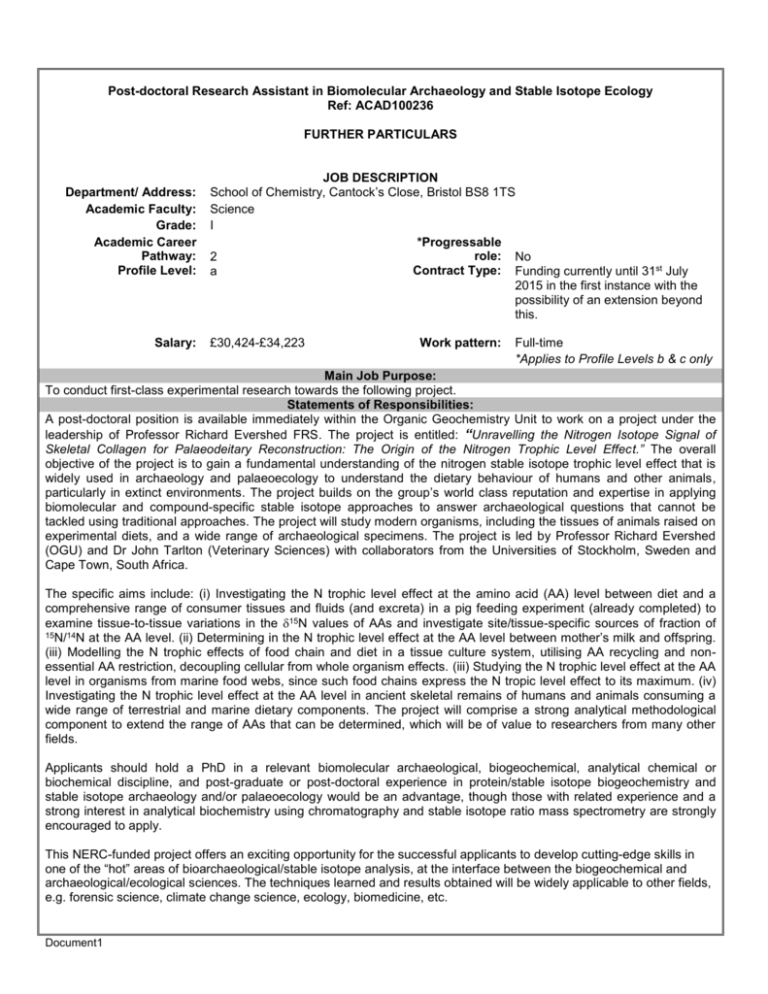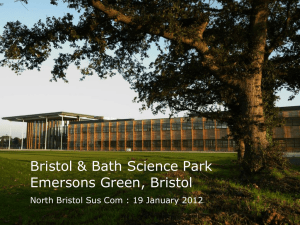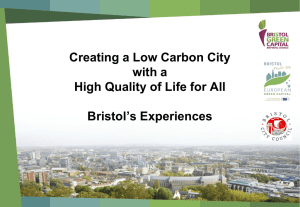When a vacancy occurs - University of Bristol
advertisement

Post-doctoral Research Assistant in Biomolecular Archaeology and Stable Isotope Ecology Ref: ACAD100236 FURTHER PARTICULARS Department/ Address: Academic Faculty: Grade: Academic Career Pathway: Profile Level: Salary: JOB DESCRIPTION School of Chemistry, Cantock’s Close, Bristol BS8 1TS Science I *Progressable role: No 2 Contract Type: Funding currently until 31st July a 2015 in the first instance with the possibility of an extension beyond this. £30,424-£34,223 Work pattern: Full-time *Applies to Profile Levels b & c only Main Job Purpose: To conduct first-class experimental research towards the following project. Statements of Responsibilities: A post-doctoral position is available immediately within the Organic Geochemistry Unit to work on a project under the leadership of Professor Richard Evershed FRS. The project is entitled: “Unravelling the Nitrogen Isotope Signal of Skeletal Collagen for Palaeodeitary Reconstruction: The Origin of the Nitrogen Trophic Level Effect.” The overall objective of the project is to gain a fundamental understanding of the nitrogen stable isotope trophic level effect that is widely used in archaeology and palaeoecology to understand the dietary behaviour of humans and other animals, particularly in extinct environments. The project builds on the group’s world class reputation and expertise in applying biomolecular and compound-specific stable isotope approaches to answer archaeological questions that cannot be tackled using traditional approaches. The project will study modern organisms, including the tissues of animals raised on experimental diets, and a wide range of archaeological specimens. The project is led by Professor Richard Evershed (OGU) and Dr John Tarlton (Veterinary Sciences) with collaborators from the Universities of Stockholm, Sweden and Cape Town, South Africa. The specific aims include: (i) Investigating the N trophic level effect at the amino acid (AA) level between diet and a comprehensive range of consumer tissues and fluids (and excreta) in a pig feeding experiment (already completed) to examine tissue-to-tissue variations in the 15N values of AAs and investigate site/tissue-specific sources of fraction of 15N/14N at the AA level. (ii) Determining in the N trophic level effect at the AA level between mother’s milk and offspring. (iii) Modelling the N trophic effects of food chain and diet in a tissue culture system, utilising AA recycling and nonessential AA restriction, decoupling cellular from whole organism effects. (iii) Studying the N trophic level effect at the AA level in organisms from marine food webs, since such food chains express the N tropic level effect to its maximum. (iv) Investigating the N trophic level effect at the AA level in ancient skeletal remains of humans and animals consuming a wide range of terrestrial and marine dietary components. The project will comprise a strong analytical methodological component to extend the range of AAs that can be determined, which will be of value to researchers from many other fields. Applicants should hold a PhD in a relevant biomolecular archaeological, biogeochemical, analytical chemical or biochemical discipline, and post-graduate or post-doctoral experience in protein/stable isotope biogeochemistry and stable isotope archaeology and/or palaeoecology would be an advantage, though those with related experience and a strong interest in analytical biochemistry using chromatography and stable isotope ratio mass spectrometry are strongly encouraged to apply. This NERC-funded project offers an exciting opportunity for the successful applicants to develop cutting-edge skills in one of the “hot” areas of bioarchaeological/stable isotope analysis, at the interface between the biogeochemical and archaeological/ecological sciences. The techniques learned and results obtained will be widely applicable to other fields, e.g. forensic science, climate change science, ecology, biomedicine, etc. Document1 BACKGROUND INFORMATION The University and the City of Bristol The University of Bristol (www.bristol.ac.uk) is an international powerhouse of learning, discovery and enterprise. Its vision is of a university whose excellence is acknowledged locally, nationally and globally. The University was rated by the Times Good University Guide 2009 as one of the top ten universities in the UK and in 2008 it was ranked within the top 35 in the world by The Times Higher Education/QS World University Rankings. The Sunday Times (September 2008) described the University of Bristol as ‘one of the jewels of British higher education’ and ‘at the cutting edge academically’. The University is a member of the Worldwide Universities Network, a grouping of 18 research-led institutions of international standing, and of the Russell Group of universities, an association of 20 major research-intensive universities of the UK. The University of Bristol is dedicated to academic achievement across a broad range of disciplines. It is made up of more than 30 departments or schools, organised in six faculties: Arts; Engineering; Medical and Veterinary Sciences; Medicine and Dentistry; Science; and Social Sciences and Law. It has approximately 12,000 undergraduate and 5,000 postgraduate students from around 100 countries. The Quality Assurance Agency for Higher Education, which carried out an institutional audit of the University in 2004, awarded Bristol the highest rating available for its management of education and the academic standards of its awards. It has 31 Fellows of the Royal Society and nine of the British Academy – a remarkable achievement for a relatively compact university. A key element of the University’s vision is to ensure that its research and education contribute to regional and national society and the economy. The University works hard to build effective links with the community and its industries, through high-quality research collaboration and productive knowledge exchange, the creation and support of new companies and enterprises, and the licensing of intellectual property. Engaging the public is a vital part of university life and an area in which staff and students are actively involved. It is part of the University’s core business and is integral to research and teaching that is grounded in societal need and that promotes lifelong learning. It is also vital to widening participation and fair access; and for students involved in volunteering, engagement is an aspect of the distinctive ‘Bristol experience’. Public engagement at the University of Bristol includes all the ways in which University staff and students interact with members of the public, encompassing talks, debates, festivals, performances, widening participation, research with, and driven by, communities, volunteering, lifelong learning, action research and engaged learning. Public engagement shares some of the same goals and principles as engagement with the business community; for example, in the need to be two-way, and not assume a top-down approach, and is part of a continuum with knowledge exchange. The University is committed to operating in a sustainable manner, working constantly to reduce carbon emissions and improve the sustainability of the physical estate. Its ambitious capital programme plans to invest in the most costeffective way in new buildings and facilities over the next few years to support research, teaching and learning. The University of Bristol is a stimulating and supportive environment for all students and staff, distinguished by a commitment to high standards, respect for the individual and a strong sense of collegiality. It is also is an integral part of a beautiful, historic city that has been selected as European City of the Year 2008, Provincial City of the Year 2008 and Britain’s most sustainable city 2008. It has been officially designated a ‘Centre of Culture’ and a ‘Science City’ by the Government. It is also the only UK city to be shortlisted for the European Green Capital Award 2010, and is England’s first ‘Cycling City’. With a population of over 400,000, Bristol is the largest city in the South West and the region’s leading centre for business, culture and education. It has a long tradition of trade and engineering, and is also home to many of the newer financial services and creative and media industries. The historic docks in the city centre, now a thriving focus for leisure and the arts, retain many echoes of Bristol’s maritime history. Theatre, music, the fine arts and cinema are all well represented, and the neighbouring city of Bath also offers a wide range of cultural activities. Bristol is well provided with open space and parkland and is within easy reach of attractive coast and countryside, including the Cotswolds and several National Parks. The city has an international airport and offers easy rail and motorway links. More information about the city of Bristol is available at http://visitbristol.co.uk and www.bristol.gov.uk. The Faculty of Science FACULTY OF SCIENCE The Faculty of Science is the largest Faculty within the University, with around 2,900 undergraduates, 850 Document1 postgraduates, 248 permanent academic staff, 350 research staff and over 200 support staff. It consists of the Schools of Biological Sciences, Chemistry and Geographical Sciences, and the Departments of Earth Sciences, Experimental Psychology, Mathematics and Physics. The individual successes of these departments have played a major part in the University of Bristol's excellent reputation. The Faculty has established good cross-departmental and cross-faculty links in teaching and research, and offers an outstanding intellectual environment for both its staff and its undergraduate and postgraduate students. Research Centres within the Faculty are the Colloid Centre, Glaciology, Behavioural Biology, Organic Geochemistry, Environmental & Geophysical Flows, Interface Analysis, IT and Law, the Laboratory for Advanced Computation, and Quantum Information. There is also BRIDGE (Bristol Initiative for the Dynamic Global Environment) in Geographical Sciences, and COGNIT (Cognition and Information Technology Research Centre) in Experimental Psychology. The very successful Molecular Recognition Centre links Science with the Faculty of Medical and Veterinary Sciences particularly well; the Quantum Information Group links Science with the Faculty of Engineering; and the School of Geographical Sciences provides an important interaction with the Faculty of Social Sciences and Law. There are strong and successful cross-faculty interactions in Climate Change, Cognition and Vision, Interface Analysis, Nanotechnology and Neuroscience. Departments in the Faculty have also been successful in external links and awards. The Earth Sciences department is host to the NERC QUEST Centre on quantifying earth systems processes, and the Mathematics department is working in partnership with GCHQ on the Heilbronn Institute for Mathematical Research. In addition, Bristol ChemLabS in the School of Chemistry is one of HEFCE's Centres of Excellence in Learning and Teaching. The Faculty is also involved in the Academic Innovation Centre (AIC) at Emerson’s Green, a joint venture company set up by Bristol and Bath Universities, which will provide accommodation and business support for high-tech companies spun out from the Universities' research. Research Assessment RAE2008, the UK Government’s audit of research quality, has confirmed that the University of Bristol's Faculty of Science is one of the UK’s leading centres of research excellence. The Faculty was ranked 3 rd among its peers in the UK, after Oxford and Cambridge, as judged by the volume weighted "grade point average" of its units of assessment. Two thirds of the Faculty’s research activity was rated at the highest 4* or 3* levels (“world leading” or “internationally excellent”) and 95% at least internationally recognised (2* or better). See http://www.bris.ac.uk/rae/results.html for a listing of all Bristol results by UoA. The Faculty made returns in 9 Units of Assessment, with the following results: UoA Biological Sciences Earth Sciences Chemistry Physics Pure Mathematics Applied Mathematics Statistics Geographical Sciences Psychology Activity profile (%) 4* 3* 2* 10 40 45 25 50 20 25 50 25 20 35 35 30 40 25 25 45 30 25 45 30 30 40 25 10 50 30 1* 5 5 0 10 5 0 0 5 10 0* 0 0 0 0 0 0 0 0 0 GPA 2.55 2.95 3.00 2.65 2.95 2.95 2.95 2.95 2.60 Doctoral Training Centres Bristol University, and the Science Faculty especially, has proved highly successful in winning competitive funding from EPSRC and other agencies to develop Doctoral Training Centres, focussed on areas of national need and emerging and interdisciplinary research themes. The Bristol Centre for Complexity Sciences admitted its first students to a 4-year MRes/PhD programme in 2007, and 4 new DTCs in Functional Nanomaterials, Chemical Synthesis, Composites and Systems Engineering were announced by EPSRC in December 2008. There are also several similar new doctoral training programmes funded by MRC, including the Bristol Centre for Systems Biomedicine which involves collaborations within the Science Faculty. School of Chemistry The School of Chemistry at the University of Bristol is one of the UK's largest and most prestigious chemistry Document1 departments. There are currently 60 members of academic staff and 30 permanent research officers and fellows, together with 60 research assistants and associates funded by external sponsors. These members of staff are supported by a large team of technical, administrative and secretarial staff. Each year, the School admits about 70 new postgraduate students to PhD programmes and 200 new undergraduate students to a range of 3-year BSc and 4-year MSci degree programmes. The School of Chemistry has strength in all areas of inorganic and materials, organic and biological and physical and theoretical chemistry. Annual grant income for the School of Chemistry continues to increase and currently exceeds £11m. Its international reputation was reflected in the most recent Research Assessment Exercise in which the GPA for the 67 members of staff returned was 3.00, indicating not only the quality and esteem of the individuals but also the research environment of the School. The School has excellent facilities in all areas of chemistry, including recently refurbished NMR spectroscopy and X-ray crystallography suites, as well as state-of-the-art laboratories for both synthetic and non-synthetic chemistry. The School also has an excellent reputation for the quality of its teaching and training. Two new EPSRC-funded Centres for Doctoral Training have recently been established in Chemical Synthesis and, joint with the Department of Physics at Bristol, in Functional Nanomaterials. It is also home to Bristol ChemLabS, the country's only HEFCE-funded Centre for Excellence in Teaching and Learning that is devoted to chemistry. The University’s Positive Working Environment The University’s Positive Working Environment (PWE) agenda is an ongoing process with the aim of making working life at the University of Bristol productive, rewarding, enjoyable and healthy for all colleagues. PWE describes the things we believe are important as an employer, and a series of actions to help us deliver them. As an employee of the University, you will have access to a range of benefits which includes, amongst others: For staff with families, those planning to have families, and those with other caring responsibilities, the University Family Life group, providing a combination of information, training and support; maternity/paternity coaching service, The University’s Early Years Nursery and a childcare voucher scheme; Professional training and support including an extensive programme of training & development courses, focus on work-life balance, tailored leadership and management workshops, flexible working policies, support groups such as the Women’s Research Group, careers guidance and a team of International Staff Advisers; For health, fitness and wellbeing, our Staff Wellness Programme, Staff Counselling Service, Staff Club, and staff member rates for the Sports Centres and the Swimming Pool; Travel to work benefits including interest-free bicycle loans, free cycle training and priority car parking spaces for car sharers, parents and carers, and a University bus shuttle. To find out more about PWE please visit http://www.bristol.ac.uk/pwe/ PERSON SPECIFICATION The qualifications, skills, knowledge and experience outlined below provide a summary of what is required to carry out this job effectively. They also form the selection criteria on which the decision on who to appoint will be made. Please ensure that you show how you meet the criteria outlined below in your application. Relevant Experience, Skills and Knowledge Essential Desirable Stable isotope analysis using isotope ratio mass Chromatography, mass spectrometry and GC-C-IRMS of spectrometry of proteins in animal tissues. Protein amino acids. Nitrogen stable isotopes. preparation Relevant Qualifications Essential Desirable PhD in a relevant biochemical, analytical chemical or Bioarchaeoelogical, palaeoecological and biochemical biomolecular archaeological discipline. expertise Document1 Communication and Interpersonal Skills Essential An ability to interact with, work within and contribute to a multidisciplinary research group comprising, biomolecular archaeologists, biochemists, organic geochemists and analytical chemists. Desirable An ability to write first drafts of scientific papers to a high standard for leading international journals. An ability to present research (updates and polished work) at informal group meetings through to national and international conferences. Additional Criteria Essential Published original research in peer-reviewed journals. Desirable CAREER PATHWAY INFORMATION As part of the process of modernising its pay and grading systems, the University has introduced career pathways for academic staff. What this means is that all members of academic staff have a clear career pathway involving a series of levels with distinct role profiles, each with its unique requirements. Each profile sets out what is expected of an academic at the particular level. The role profiles also set out a collection of competencies expected for each level. Progression or promotion to the next level will occur after these competencies have been attained. The four academic pathways are as follows: Career Pathway One - academic roles that combine teaching, research and administrative duties. Career Pathway Two - academic roles focusing on research and associated administrative duties. Career Pathway Three - academic roles focusing on teaching and associated administrative duties. Clinical Career Pathways - Sub-sets of the other pathways covering roles that also include clinical duties. This post is located on Pathway Two. Role Summaries setting out what is expected of an academic at each particular profile level on pathway two can be found below. Please note that an appointment may be made at any level of the pathway. A schematic diagram of the career pathways is also attached and further information on career pathways can be found at www.bris.ac.uk/personnel/reward/acadpath Role Summary Research Assistant (Level A) Role holders at this level are concerned with assisting an individual research leader or team to conduct a particular study (or group of studies). They will generally be involved in data generation and/or collection using standard and welldefined methods developed by others. They will be working under close supervision by, and direction from, a more senior researcher, who will be ultimately responsible for the project. This may be the entry level for some staff who are expected to train and/or develop to take on more senior researcher roles. Role holders will be provided with academic and pastoral support within the department (including counselling on realistic career opportunities) and training will be available designed to develop their competences and to prepare them to take on more responsibilities associated with a higher grade. ORGANISATION CHART Head of School Document1 School Manager Deputy Head of School Inorganic & Materials Section Technical Manager Organic & Biological Section Physical & Theoretical Section Administrative Staff Technical Staff Doctoral Training Centres Bristol ChemLabS APPLICATION PROCESS Please visit our website at www.bris.ac.uk/jobs, enter vacancy number ACAD100236 into the job search and follow the link to the online application process. The closing date for applications is 15th March 2013. For further information on the University’s application process can be found at: http://www.bristol.ac.uk/jobs/applicationprocess.html SELECTION PROCESS It is expected that interviews will be held in March 2013. ADDITIONAL INFORMATION Contract Type If successful, you may be appointed either on a fixed-term or an open-ended contract depending on the extent of your previous relevant research experience. Three years’ appropriate and relevant experience at another higher education institution would normally lead to an appointment on an open-ended contract. Further information can be found at www.bristol.ac.uk/hr/ftc/ Document1 Document1






